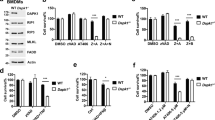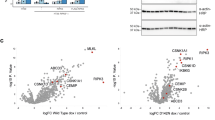Abstract
Apoptosis signal-regulating kinase 1 (ASK1) is a serine/threonine kinase that mediates cell stress signaling initiated by diverse stimuli, such as H2O2 and TNFα. Owing to its critical role in promoting apoptosis, ASK1 activity is highly controlled in cells. Phosphorylation of ASK1 at Thr-845 has been correlated with its activation, while phosphorylation at Ser-967 negatively controls its death promoting activity. Here, we report the identification of a novel phosphorylation site at Ser-1034 in the C-terminal regulatory domain of ASK1. Mutating Ser-1034 to an unphosphorylatable Ala led to increased catalytic activity of ASK1 and enhanced proapoptotic function of ASK1. Thus, the proapoptotic function of ASK1 is suppressed in part by phosphorylation at its C-terminal regulatory domain, which may couple upstream survival kinases to the death regulatory machinery.
This is a preview of subscription content, access via your institution
Access options
Subscribe to this journal
Receive 50 print issues and online access
$259.00 per year
only $5.18 per issue
Buy this article
- Purchase on Springer Link
- Instant access to full article PDF
Prices may be subject to local taxes which are calculated during checkout




Similar content being viewed by others
Abbreviations
- ASK1:
-
Apoptosis signal-regulating kinase 1
- HA:
-
hemagglutinin
- IP:
-
immunoprecipitate
- JNK/SAPK:
-
c-Jun N-terminal kinase/stress-activated protein kinase
- MAPK:
-
mitogen-activated protein kinase
- PMSF:
-
phenylmethylsulfonyl fluoride
- TNF:
-
tumor necrosis factor
- TRAF:
-
TNF receptor-associated factor
- WT:
-
wild type
- DAPI:
-
4′,6-diamidino-2-phenylindole
References
Boyle WJ, van der Geer P and Hunter T . (1991). Methods Enzymol., 201, 110–149.
Chang HY, Nishitoh H, Yang X, Ichijo H and Baltimore D . (1998). Science, 281, 1860–1863.
Chen J, Fujii K, Zhang L, Roberts T and Fu H . (2001). Proc. Natl. Acad. Sci. USA, 98, 7783–7788.
Chen Z, Seimiya H, Naito M, Mashima T, Kizaki A, Dan S, Imaizumi M, Ichijo H, Miyazono K and Tsuruo T . (1999). Oncogene, 18, 173–180.
Datta SR, Brunet A and Greenberg ME . (1999). Genes Dev., 13, 2905–2927.
Fu H, Subramanian RR and Masters SC . (2000). Annu. Rev. Pharmacol. Toxicol., 40, 617–647.
Goldman EH, Chen L and Fu H . (2004). J. Biol. Chem., 279, 10442–10449.
Gotoh Y and Cooper JA . (1998). J. Biol. Chem., 273, 17477–17482.
Green DR and Evan GI . (2002). Cancer Cell, 1, 19–30.
Hatai T, Matsuzawa A, Inoshita S, Mochida Y, Kuroda T, Sakamaki K, Kuida K, Yonehara S, Ichijo H and Takeda K . (2000). J. Biol. Chem., 275, 26576–26581.
Ichijo H, Nishida E, Irie K, ten Dijke P, Saitoh M, Moriguchi T, Takagi M, Matsumoto K, Miyazono K and Gotoh Y . (1997). Science, 275, 90–94.
Kim AH, Khursigara G, Sun X, Franke TF and Chao MV . (2001). Mol. Cell Biol., 21, 893–901.
Liu H, Nishitoh H, Ichijo H and Kyriakis JM . (2000). Mol. Cell Biol., 20, 2198–2208.
Matsuura H, Nishitoh H, Takeda K, Matsuzawa A, Amagasa T, Ito M, Yoshioka K and Ichijo H . (2002). J. Biol. Chem., 277, 40703–40709.
Matsuzawa A and Ichijo H . (2001). J. Biochem. (Tokyo), 130, 1–8.
Morita K, Saitoh M, Tobiume K, Matsuura H, Enomoto S, Nishitoh H and Ichijo H . (2001). EMBO J., 20, 6028–6036.
Nishitoh H, Saitoh M, Mochida Y, Takeda K, Nakano H, Rothe M, Miyazono K and Ichijo H . (1998). Mol. Cell., 2, 389–395.
Park HS, Cho SG, Kim CK, Hwang HS, Noh KT, Kim MS, Huh SH, Kim MJ, Ryoo K, Kim EK, Kang WJ, Lee JS, Seo JS, Ko YG, Kim S and Choi EJ . (2002). Mol. Cell Biol., 22, 7721–7730.
Saitoh M, Nishitoh H, Fujii M, Takeda K, Tobiume K, Sawada Y, Kawabata M, Miyazono K and Ichijo H . (1998). EMBO J., 17, 2596–2606.
Song JJ, Rhee JG, Suntharalingam M, Walsh SA, Spitz DR and Lee YJ . (2002). J. Biol. Chem., 277, 46566–46575.
Tobiume K, Matsuzawa A, Takahashi T, Nishitoh H, Morita K, Takeda K, Minowa O, Miyazono K, Noda T and Ichijo H . (2001). EMBO Rep., 2, 222–228.
Tobiume K, Saitoh M and Ichijo H . (2002). J. Cell Physiol., 191, 95–104.
Wang TH, Popp DM, Wang HS, Saitoh M, Mural JG, Henley DC, Ichijo H and Wimalasena J . (1999). J. Biol. Chem., 274, 8208–8216.
Wang TH, Wang HS, Ichijo H, Giannakakou P, Foster JS, Fojo T and Wimalasena J . (1998). J. Biol. Chem., 273, 4928–4936.
Wang XS, Diener K, Jannuzzi D, Trollinger D, Tan TH, Lichenstein H, Zukowski M and Yao Z . (1996). J. Biol. Chem., 271, 31607–31611.
Yaffe MB, Leparc GG, Lai J, Obata T, Volinia S and Cantley LC . (2001). Nat. Biotechnol., 19, 348–353.
Zhang L, Chen J and Fu H . (1999). Proc. Natl. Acad. Sci. USA, 96, 8511–8515.
Zou X, Tsutsui T, Ray D, Blomquist JF, Ichijo H, Ucker DS and Kiyokawa H . (2001). Mol. Cell Biol., 21, 4818–4828.
Acknowledgements
We thank members of the Fu lab for helpful discussions, Lisa Montoya Cockrell for assistance in manuscript preparation, and Dr Bill Lane of Harvard Microchemistry facility for phosphopeptide sequence analysis. This work was supported in part by grants from American Heart Association (9950226N) and NIH/National Institute of General Medical Sciences (GM60033 and GM53165).
Author information
Authors and Affiliations
Corresponding author
Rights and permissions
About this article
Cite this article
Fujii, K., Goldman, E., Park, H. et al. Negative control of apoptosis signal-regulating kinase 1 through phosphorylation of Ser-1034. Oncogene 23, 5099–5104 (2004). https://doi.org/10.1038/sj.onc.1207668
Received:
Revised:
Accepted:
Published:
Issue Date:
DOI: https://doi.org/10.1038/sj.onc.1207668
Keywords
This article is cited by
-
Phosphoproteomics reveals rewiring of the insulin signaling network and multi-nodal defects in insulin resistance
Nature Communications (2023)
-
Cell cycle-dependent Cdc25C phosphatase determines cell survival by regulating apoptosis signal-regulating kinase 1
Cell Death & Differentiation (2015)
-
ASK1
AfCS-Nature Molecule Pages (2010)
-
PIM1 phosphorylates and negatively regulates ASK1-mediated apoptosis
Oncogene (2009)



